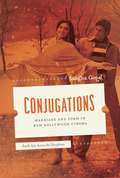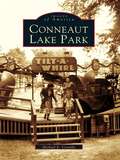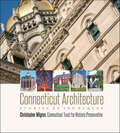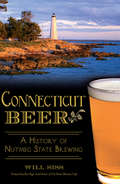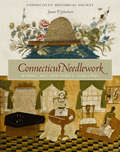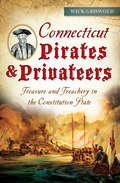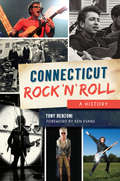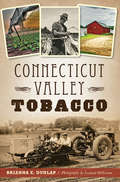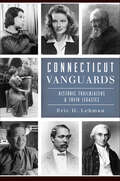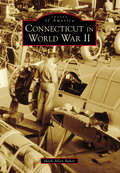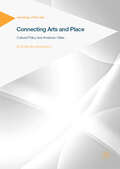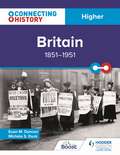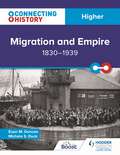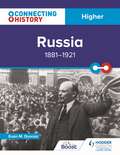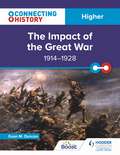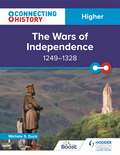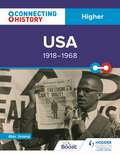- Table View
- List View
Conjugal Relationships in Chinese Culture: Sino-Western Discourses and Aesthetics on Marriage (Chinese Culture #7)
by Kelly Kar Yue Chan Chi Sum Garfield LauThis book reviews the presentation of conjugal relationships in Chinese culture and their perception in the West. It explores the ways in which the act of marriage is represented/misrepresented in different literary genres, as well as in cultural adaptations. It looks at the gendered characteristics at play that affect conjugal relationships in Chinese societal practices more widely. It also distinguishes between the essential features that give rise to nuptial arrangements from the Chinese perspective, looking at what in which Sino and/or Western mentalities differ in terms of notions of autonomy in marriage. It excavates the extent to which marriage is constituted in forms of transaction between female and male bodies and asks under what circumstances wedding ceremonies constitute archetypal or counter-archetypal notions in pre-modern and modern society. Authors cover a range of fascinating cultural topics, such as posthumous marriage (necrogamy) as an ancient and popular folk culture from the perspective of Confucian ideology, as well as looking at marriage from ancient to present times, duty and rights in conjugal relations, inter-racial and inter-cultural marriage, widowhood in Confucian ideology, issues of legitimacy in marriage and concubinage, the taboos surrounding divorce and re-marriage, and conjugal violence. The book serves to revisit the cultural connections between marriage and various art forms, including literature, film, theatre, and other adaptations. It is a rich intellectual resource for scholars and students researching the historical roots, cultural interpretations, and evolving aspects of marriage as shown in literature, art, and culture.
Conjugations
by Sangita GopalBollywood movies have been long known for their colorful song-and-dance numbers and knack for combining drama, comedy, action-adventure, and music. But when India entered the global marketplace in the early 1990s, its film industry transformed radically. Production and distribution of films became regulated, advertising and marketing created a largely middle-class audience, and films began to fit into genres like science fiction and horror. In this bold study of what she names New Bollywood, Sangita Gopal contends that the key to understanding these changes is to analyze films' evolving treatment of romantic relationships. Gopalargues that the form of the conjugal duo in movies reflects other social forces in India's new consumerist and global society. She takes a daring look at recent Hindi films and movie trends--the decline of song-and-dance sequences, the upgraded status of the horror genre, and the rise of the multiplex and multi-plot--to demonstrate how these relationships exemplify different formulas of contemporary living. A provocative account of how cultural artifacts can embody globalization's effects on intimate life, Conjugations will shake up the study of Hindi film.
Conneaut Lake Park
by Michael E. CostelloIn 1877, a humble boat landing was constucted on Conneaut Lake, Pennsylvania's largest natural lake. Colonel Frank Mantor, a visionary, discovered and purchased the property and convinced investors from the Pittsburgh, Shenango, and Lake Erie Railroad to extend the railroad line to a newly built resort on the site. In 1892, Exposition Park--a permanent fair exhibiting machinery and livestock--was founded. Amusement rides wereadded alongside hotels, cottages, restaurants, and other businesses. The resort grew into an amusement park and was renamed Conneaut Lake Park in 1920. Conneaut Lake Park illustrates the evolution of this lakeside resort with images of long-gone attractions such as the Hotel Elmwood, Temple of Music, Jungle Cruise, Fairyland Forest, and Wild Mouse. Recent favorites such as the Blue Streak, Tumble Bug, Ultimate Trip, and Devil's Den are also included.
Connect the Shapes Crochet Motifs: Creative Techniques for Joining Motifs of All Shapes
by Edie EckmanConnecting beautiful motifs can be just as enjoyable as crocheting them. Edie Eckman’s creative joining techniques allow you to easily combine multiples to form a whole new pattern, from lacy links, swirls, radiants, and wheels to three-dimensional effects. <P><P>Step-by-step instructions, detailed photography, and innovative stitching charts ensure success. With 100 brand-new motif designs at your fingertips, you’ll be free to explore limitless variations and capture your own personal style.
Connected Viewing: Selling, Streaming, & Sharing Media in the Digital Age
by Jennifer Holt Kevin SansonAs patterns of media use become more integrated with mobile technologies and multiple screens, a new mode of viewer engagement has emerged in the form of connected viewing, which allows for an array of new relationships between audiences and media texts in the digital space. This exciting new collection brings together twelve original essays that critically engage with the socially-networked, multi-platform, and cloud-based world of today, examining the connected viewing phenomenon across television, film, video games, and social media. The result is a wide-ranging analysis of shifting business models, policy matters, technological infrastructure, new forms of user engagement, and other key trends affecting screen media in the digital era. Connected Viewing contextualizes the dramatic transformations taking place across both media industries and national contexts, and offers students and scholars alike a diverse set of methods and perspectives for studying this critical moment in media culture.
Connecticut Architecture: Stories of 100 Places (Garnet)
by Christopher WigrenConnecticut boasts some of the oldest and most distinctive architecture in New England, from Colonial churches and Modernist houses to refurbished nineteenth-century factories. The state's history includes landscapes of small farmsteads, country churches, urban streets, tobacco sheds, quiet maritime villages, and town greens, as well as more recent suburbs and corporate headquarters. In his guide to this rich and diverse architectural heritage, Christopher Wigren introduces readers to 100 places across the state. Written for travelers and residents alike, the book features buildings visible from the road.Featuring more than 200 illustrations, the book is organized thematically. Sections include concise entries that treat notable buildings, neighborhoods, and communities, emphasizing the importance of the built environment and its impact on our sense of place. The text highlights key architectural features and trends and relates buildings to the local and regional histories they represent.There are suggestions for further reading and a helpful glossary of architectural termsA project of the Connecticut Trust for Historic Preservation, the book reflects more than 30 years of fieldwork and research in statewide architectural survey and National Register of Historic Places programs.
Connecticut Beer: A History of Nutmeg State Brewing (American Palate)
by Will Siss Ron PageThe history of the frothy beverage in Connecticut dates back to early colonists, who used it to quench their thirst in the absence of clean drinking water. So integral was beer to daily life in the colony that government officials and militiamen congregated in taverns like the General Wolfe to talk laws and business over pints of ale. Over the next two centuries, the number of breweries rose and then declined, especially after Prohibition. It was not until the 1980s that homebrewers brought this vital Nutmeg State tradition back to life, hatching the likes of New England and Cottrell Brewing Companies, as well as brewpubs including City Steam and Southport Brewing. More recently, small operations with one or two people, such as Relic and Beer'd, are changing the landscape again. Connecticut beer writer Will Siss introduces readers to the hardworking people who keep the breweries and beer bars inviting and the hoppy history alive.
Connecticut Needlework: Women, Art, and Family, 1740–1840
by Kate Steinway Susan P. SchoelwerConnecticut women have long been noted for their creation of colorful and distinctive needlework, including samplers and family registers, bed rugs and memorial pictures, crewel-embroidered bed hangings and garments, silk-embroidered pictures of classical or religious scenes, quilted petticoats and bedcovers, and whitework dresses and linens. This volume offers the first regional study, encompassing the full range of needle arts produced prior to 1840. Seventy entries showcase more than one hundred fascinating examples--many never before published--from the Connecticut Historical Society's extensive collection of this early American art form. Produced almost exclusively by women and girls, the needle arts provide an illuminating vantage point for exploring early American women's history and education, including family-based traditions predating the establishment of formal academies after the American Revolution. Extensive genealogical research reveals unseen family connections linking various types of needlework, similar to the multi-generational male workshops documented for other artisan trades, such as woodworking or metalsmithing. Photographs of stitches, reverse sides, sketches, design sources, and related works enhance our understanding and appreciation of this fragile art form and the talented women who created it. An exhibition of needlework in this book will be held at the Connecticut Historical Society in late fall, 2010. Funding for this project has been provided by the Coby Foundation, Ltd., and the National Endowment for the Arts.
Connecticut Pirates & Privateers: Treasure and Treachery in the Constitution State
by Wick GriswoldThe waters, inlets and islands of Connecticut once swarmed with fabled corsairs like Captain Kidd and Blackbeard who may have buried their booty in Constitution State soil. In colonial times and through the nineteenth century, over one hundred privateers used the Connecticut River and waterways as a home port, influencing the geopolitics of the time. During the Revolutionary War, the infamous traitor Benedict Arnold attempted to destroy the state's privateer fleet. In 1779, Captain Elisha Hinman cleverly devised a system that allowed the large privateer ship Governor Trumbull to avoid enemy attack by becoming super-buoyant and passing over dangerous shoals. Wick Griswold uncovers the swashbuckling stories of Connecticut's pirates and privateers, brimming with historical facts and local myths.
Connecticut Rock ‘n’ Roll: A History
by Ken Evans Tony RenzoniLong neglected in the annals of American music, the Nutmeg State’s influence on the history of rock’n’roll deserves recognition. Connecticut’s musical highlights include the beautiful harmonies of New Haven’s Five Satins, Gene Pitney’s rise to fame, Stamford’s the Fifth Estate and notable rockers such as Thurston Moore of Sonic Youth, Rivers Cuomo of Weezer and Saturday Night Live Band’s Christine Ohlman. Rock Hall of Famers include Tina Weymouth and Chris Frantz of the Talking Heads and Dennis Dunaway of the Alice Cooper Band. Some events became legend, like Jimi Hendrix’s spellbinding performance at Yale’s Woolsey Hall, Jim Morrison’s onstage arrest at the New Haven Arena and teenage Bob Dylan’s appearance at Branford’s Indian Neck Folk Festival. With in-depth interviews as well as rare, never-before-seen photos, author Tony Renzoni leads a sonic trip that captures the spirit and zenith of the local scene.
Connecticut Valley Tobacco
by Brianna E. Dunlap Leonard HellermanCigar tobacco runs in the blood of Connecticut River Valley farmers. Delve into the surprising history of the region's most iconic crop, all the way back to early Native American uses and the boom of the Civil War. Though fashionable in the 1950s, the popularity of cigars declined a decade later, nearly destroying the region's tobacco industry. A resurgence in the 1990s brought new life to the crop, and the reopening of Cuba in 2015 added a new chapter for cigar tobacco. Brianna Dunlap, director of the Connecticut Valley Tobacco Museum, provides a guide to important tobacco landmarks from East Haddam to Brattleboro, featuring stunning photography from Leonard Hellerman. It is the story of the people--the farmers and field hands--who made tobacco the soul of the valley.
Connecticut Vanguards: Historic Trailblazers & Their Legacies
by Eric D. LehmanAuthor Eric D. Lehman chronicles the lives of two dozen men and women who left their marks on Connecticut and the world as a whole.Noah Webster, Charles Goodyear, P.T. Barnum and Katharine Hepburn all have Connecticut in common. Like so many other residents, they had an inventive spirit and drive that changed the course of history for the rest of the state. Some of the state's natives, like Eli Whitney and Henry C. Lee, pioneered new methods. Prudence Crandall and Helen Keller championed the rights of the underprivileged. Some, like Frederick Law Olmsted and Sol LeWitt, changed our perception of the world.
Connecticut in World War II (Images of America)
by Mark Allen BakerWith the attack on Pearl Harbor by the Empire of Japan on December 7, 1941, and the United States� entry into World War II, our nation turned to Connecticut�as it did during World War I�for munitions, clothing, and other goods. And Connecticut answered the call: Manchester Mills increased silk production, Waterbury brass producers altered their manufacturing lines, and Bridgeport�s Remington Arms�which had produced 50 percent of the US Army�s small arms cartridges in World War I�increased its mass production capabilities. By the time Electric Boat, Hamilton Propellers, Pratt & Whitney, and many other Connecticut companies tallied up their production back in 1945, it amounted to over $8 billion in war contracts.
Connecting Arts and Place: Cultural Policy and American Cities (Sociology of the Arts)
by Eleonora RedaelliIn this book, Eleonora Redaelli investigates the arts in American cities, providing insight into urban cultural policy discourse through the lens of space. By unpacking the ways in which scholars and policymakers account for geographic configuration and spatial relation, this monograph presents a unique approach to the arts and public policy. Redaelli analyses five main concepts of the international discourse in cultural policy — cultural planning, cultural mapping, creative industries, cultural districts and creative placemaking — highlighting how each of them contributes to the understanding of how the arts connect with place. Employing a selection of American cities as case, this book is an essential contribution to our understanding of cultural policy and its effects. It will be of interest to students and scholars of sociology, public policy, urban studies, arts management and cultural studies.
Connecting History: Higher Britain, 1851–1951
by Euan M. DuncanExam board: SQALevel: HigherSubject: HistoryFirst teaching: September 2018First exam: Summer 2019Fresh stories, fresh scholarship and a fresh structure. Connecting History informs and empowers tomorrow's citizens, today.Bringing together lesser-told narratives, academic excellence, accessibility and a sharp focus on assessment success, this series provides a rich, relevant and representative History curriculum.> Connect the past to the present. Overarching themes of social justice, equality, change and power help students to understand the importance of events and issues, then and now.> Go far beyond other resources. With respect and aspiration for the transformative power of History, this series incorporates the latest research, challenges old interpretations and embeds diverse experiences throughout.> Follow a clear and consistent structure. The key issues in the specification form the chapters in each book, and the content descriptors are subheadings within the chapters. Finding the information that you need has never been easier.> Meet the demands of the assessments. Connecting History develops the knowledge and skills for success, with appropriate breadth, depth and pace. The narrative and sources take centre stage and the authors model the process of answering questions effectively through that narrative, ensuring that students have enough key points to achieve full marks. End-of-chapter activities consolidate and extend learning.> Benefit from pedagogic and academic expertise. The authors are highly experienced teachers and examiners who know how to spark critical curiosity in students. Each book has been rigorously reviewed by an academic from the University of Glasgow, so you can rest assured that the content is accurate and up to date.
Connecting History: Higher Britain, 1851–1951
by Euan M. DuncanExam board: SQALevel: HigherSubject: HistoryFirst teaching: September 2018First exam: Summer 2019Fresh stories, fresh scholarship and a fresh structure. Connecting History informs and empowers tomorrow's citizens, today.Bringing together lesser-told narratives, academic excellence, accessibility and a sharp focus on assessment success, this series provides a rich, relevant and representative History curriculum.> Connect the past to the present. Overarching themes of social justice, equality, change and power help students to understand the importance of events and issues, then and now.> Go far beyond other resources. With respect and aspiration for the transformative power of History, this series incorporates the latest research, challenges old interpretations and embeds diverse experiences throughout.> Follow a clear and consistent structure. The key issues in the specification form the chapters in each book, and the content descriptors are subheadings within the chapters. Finding the information that you need has never been easier.> Meet the demands of the assessments. Connecting History develops the knowledge and skills for success, with appropriate breadth, depth and pace. The narrative and sources take centre stage and the authors model the process of answering questions effectively through that narrative, ensuring that students have enough key points to achieve full marks. End-of-chapter activities consolidate and extend learning.> Benefit from pedagogic and academic expertise. The authors are highly experienced teachers and examiners who know how to spark critical curiosity in students. Each book has been rigorously reviewed by an academic from the University of Glasgow, so you can rest assured that the content is accurate and up to date.
Connecting History: Higher Germany, 1815–1939
by Euan M. DuncanExam board: SQALevel: HigherSubject: HistoryFirst teaching: September 2018First exam: Summer 2019Fresh stories, fresh scholarship and a fresh structure. Connecting History informs and empowers tomorrow's citizens, today.Bringing together lesser-told narratives, academic excellence, accessibility and a sharp focus on assessment success, this series provides a rich, relevant and representative History curriculum.> Connect the past to the present. Overarching themes of social justice, equality, change and power help students to understand the importance of events and issues, then and now.> Go far beyond other resources. With respect and aspiration for the transformative power of History, this series incorporates the latest research, challenges old interpretations and embeds diverse experiences throughout.> Follow a clear and consistent structure. The key issues in the specification form the chapters in each book, and the content descriptors are subheadings within the chapters. Finding the information that you need has never been easier.> Meet the demands of the assessments. Connecting History develops the knowledge and skills for success, with appropriate breadth, depth and pace. The narrative and sources take centre stage and the authors model the process of answering questions effectively through that narrative, ensuring that students have enough key points to achieve full marks. End-of-chapter activities consolidate and extend learning.> Benefit from pedagogic and academic expertise. The authors are highly experienced teachers and examiners who know how to spark critical curiosity in students. Each book has been rigorously reviewed by an academic from the University of Glasgow, so you can rest assured that the content is accurate and up to date.
Connecting History: Higher Migration and Empire, 1830–1939
by Euan M. Duncan Michèle Sine DuckExam board: SQALevel: HigherSubject: HistoryFirst teaching: September 2018First exam: Summer 2019Fresh stories, fresh scholarship and a fresh structure. Connecting History informs and empowers tomorrow's citizens, today.Bringing together lesser-told narratives, academic excellence, accessibility and a sharp focus on assessment success, this series provides a rich, relevant and representative History curriculum.> Connect the past to the present. Overarching themes of social justice, equality, change and power help students to understand the importance of events and issues, then and now.> Go far beyond other resources. With respect and aspiration for the transformative power of History, this series incorporates the latest research, challenges old interpretations and embeds diverse experiences throughout.> Follow a clear and consistent structure. The key issues in the specification form the chapters in each book, and the content descriptors are subheadings within the chapters. Finding the information that you need has never been easier.> Meet the demands of the assessments. Connecting History develops the knowledge and skills for success, with appropriate breadth, depth and pace. The narrative and sources take centre stage and the authors model the process of answering questions effectively through that narrative, ensuring that students have enough key points to achieve full marks. End-of-chapter activities consolidate and extend learning.> Benefit from pedagogic and academic expertise. The authors are highly experienced teachers and examiners who know how to spark critical curiosity in students. Each book has been rigorously reviewed by an academic from the University of Glasgow, so you can rest assured that the content is accurate and up to date.
Connecting History: Higher Migration and Empire, 1830–1939
by Euan M. Duncan Michèle Sine DuckExam board: SQALevel: HigherSubject: HistoryFirst teaching: September 2018First exam: Summer 2019Fresh stories, fresh scholarship and a fresh structure. Connecting History informs and empowers tomorrow's citizens, today.Bringing together lesser-told narratives, academic excellence, accessibility and a sharp focus on assessment success, this series provides a rich, relevant and representative History curriculum.> Connect the past to the present. Overarching themes of social justice, equality, change and power help students to understand the importance of events and issues, then and now.> Go far beyond other resources. With respect and aspiration for the transformative power of History, this series incorporates the latest research, challenges old interpretations and embeds diverse experiences throughout.> Follow a clear and consistent structure. The key issues in the specification form the chapters in each book, and the content descriptors are subheadings within the chapters. Finding the information that you need has never been easier.> Meet the demands of the assessments. Connecting History develops the knowledge and skills for success, with appropriate breadth, depth and pace. The narrative and sources take centre stage and the authors model the process of answering questions effectively through that narrative, ensuring that students have enough key points to achieve full marks. End-of-chapter activities consolidate and extend learning.> Benefit from pedagogic and academic expertise. The authors are highly experienced teachers and examiners who know how to spark critical curiosity in students. Each book has been rigorously reviewed by an academic from the University of Glasgow, so you can rest assured that the content is accurate and up to date.
Connecting History: Higher Russia, 1881–1921
by Euan M. DuncanExam board: SQALevel: HigherSubject: HistoryFirst teaching: September 2018First exam: Summer 2019Fresh stories, fresh scholarship and a fresh structure. Connecting History informs and empowers tomorrow's citizens, today.Bringing together lesser-told narratives, academic excellence, accessibility and a sharp focus on assessment success, this series provides a rich, relevant and representative History curriculum.> Connect the past to the present. Overarching themes of social justice, equality, change and power help students to understand the importance of events and issues, then and now.> Go far beyond other resources. With respect and aspiration for the transformative power of History, this series incorporates the latest research, challenges old interpretations and embeds diverse experiences throughout.> Follow a clear and consistent structure. The key issues in the specification form the chapters in each book, and the content descriptors are subheadings within the chapters. Finding the information that you need has never been easier.> Meet the demands of the assessments. Connecting History develops the knowledge and skills for success, with appropriate breadth, depth and pace. The narrative and sources take centre stage and the authors model the process of answering questions effectively through that narrative, ensuring that students have enough key points to achieve full marks. End-of-chapter activities consolidate and extend learning.> Benefit from pedagogic and academic expertise. The authors are highly experienced teachers and examiners who know how to spark critical curiosity in students. Each book has been rigorously reviewed by an academic from the University of Glasgow, so you can rest assured that the content is accurate and up to date.
Connecting History: Higher Russia, 1881–1921
by Euan M. DuncanExam board: SQALevel: HigherSubject: HistoryFirst teaching: September 2018First exam: Summer 2019Fresh stories, fresh scholarship and a fresh structure. Connecting History informs and empowers tomorrow's citizens, today.Bringing together lesser-told narratives, academic excellence, accessibility and a sharp focus on assessment success, this series provides a rich, relevant and representative History curriculum.> Connect the past to the present. Overarching themes of social justice, equality, change and power help students to understand the importance of events and issues, then and now.> Go far beyond other resources. With respect and aspiration for the transformative power of History, this series incorporates the latest research, challenges old interpretations and embeds diverse experiences throughout.> Follow a clear and consistent structure. The key issues in the specification form the chapters in each book, and the content descriptors are subheadings within the chapters. Finding the information that you need has never been easier.> Meet the demands of the assessments. Connecting History develops the knowledge and skills for success, with appropriate breadth, depth and pace. The narrative and sources take centre stage and the authors model the process of answering questions effectively through that narrative, ensuring that students have enough key points to achieve full marks. End-of-chapter activities consolidate and extend learning.> Benefit from pedagogic and academic expertise. The authors are highly experienced teachers and examiners who know how to spark critical curiosity in students. Each book has been rigorously reviewed by an academic from the University of Glasgow, so you can rest assured that the content is accurate and up to date.
Connecting History: Higher The Impact of the Great War, 1914–1928
by Euan M. DuncanExam board: SQALevel: HigherSubject: HistoryFirst teaching: September 2018First exam: Summer 2019Fresh stories, fresh scholarship and a fresh structure. Connecting History informs and empowers tomorrow's citizens, today.Bringing together lesser-told narratives, academic excellence, accessibility and a sharp focus on assessment success, this series provides a rich, relevant and representative History curriculum.> Connect the past to the present. Overarching themes of social justice, equality, change and power help students to understand the importance of events and issues, then and now.> Go far beyond other resources. With respect and aspiration for the transformative power of History, this series incorporates the latest research, challenges old interpretations and embeds diverse experiences throughout.> Follow a clear and consistent structure. The key issues in the specification form the chapters in each book, and the content descriptors are subheadings within the chapters. Finding the information that you need has never been easier.> Meet the demands of the assessments. Connecting History develops the knowledge and skills for success, with appropriate breadth, depth and pace. The narrative and sources take centre stage and the authors model the process of answering questions effectively through that narrative, ensuring that students have enough key points to achieve full marks. End-of-chapter activities consolidate and extend learning.> Benefit from pedagogic and academic expertise. The authors are highly experienced teachers and examiners who know how to spark critical curiosity in students. Each book has been rigorously reviewed by an academic from the University of Glasgow, so you can rest assured that the content is accurate and up to date.
Connecting History: Higher The Wars of Independence, 1249–1328
by Michèle Sine DuckExam board: SQALevel: HigherSubject: HistoryFirst teaching: September 2018First exam: Summer 2019Fresh stories, fresh scholarship and a fresh structure. Connecting History informs and empowers tomorrow's citizens, today.Bringing together lesser-told narratives, academic excellence, accessibility and a sharp focus on assessment success, this series provides a rich, relevant and representative History curriculum.> Connect the past to the present. Overarching themes of social justice, equality, change and power help students to understand the importance of events and issues, then and now.> Go far beyond other resources. With respect and aspiration for the transformative power of History, this series incorporates the latest research, challenges old interpretations and embeds diverse experiences throughout.> Follow a clear and consistent structure. The key issues in the specification form the chapters in each book, and the content descriptors are subheadings within the chapters. Finding the information that you need has never been easier.> Meet the demands of the assessments. Connecting History develops the knowledge and skills for success, with appropriate breadth, depth and pace. The narrative and sources take centre stage and the authors model the process of answering questions effectively through that narrative, ensuring that students have enough key points to achieve full marks. End-of-chapter activities consolidate and extend learning.> Benefit from pedagogic and academic expertise. The authors are highly experienced teachers and examiners who know how to spark critical curiosity in students. Each book has been rigorously reviewed by an academic from the University of Glasgow, so you can rest assured that the content is accurate and up to date.
Connecting History: Higher USA, 1918–1968
by Alec JessopExam board: SQALevel: HigherSubject: HistoryFirst teaching: September 2018First exam: Summer 2019Fresh stories, fresh scholarship and a fresh structure. Connecting History informs and empowers tomorrow's citizens, today.Bringing together lesser-told narratives, academic excellence, accessibility and a sharp focus on assessment success, this series provides a rich, relevant and representative History curriculum.> Connect the past to the present. Overarching themes of social justice, equality, change and power help students to understand the importance of events and issues, then and now.> Go far beyond other resources. With respect and aspiration for the transformative power of History, this series incorporates the latest research, challenges old interpretations and embeds diverse experiences throughout.> Follow a clear and consistent structure. The key issues in the specification form the chapters in each book, and the content descriptors are subheadings within the chapters. Finding the information that you need has never been easier.> Meet the demands of the assessments. Connecting History develops the knowledge and skills for success, with appropriate breadth, depth and pace. The narrative and sources take centre stage and the authors model the process of answering questions effectively through that narrative, ensuring that students have enough key points to achieve full marks. End-of-chapter activities consolidate and extend learning.> Benefit from pedagogic and academic expertise. The authors are highly experienced teachers and examiners who know how to spark critical curiosity in students. Each book has been rigorously reviewed by an academic from the University of Glasgow, so you can rest assured that the content is accurate and up to date.
Connecting History: Higher USA, 1918–1968
by Alec JessopExam board: SQALevel: HigherSubject: HistoryFirst teaching: September 2018First exam: Summer 2019Fresh stories, fresh scholarship and a fresh structure. Connecting History informs and empowers tomorrow's citizens, today.Bringing together lesser-told narratives, academic excellence, accessibility and a sharp focus on assessment success, this series provides a rich, relevant and representative History curriculum.> Connect the past to the present. Overarching themes of social justice, equality, change and power help students to understand the importance of events and issues, then and now.> Go far beyond other resources. With respect and aspiration for the transformative power of History, this series incorporates the latest research, challenges old interpretations and embeds diverse experiences throughout.> Follow a clear and consistent structure. The key issues in the specification form the chapters in each book, and the content descriptors are subheadings within the chapters. Finding the information that you need has never been easier.> Meet the demands of the assessments. Connecting History develops the knowledge and skills for success, with appropriate breadth, depth and pace. The narrative and sources take centre stage and the authors model the process of answering questions effectively through that narrative, ensuring that students have enough key points to achieve full marks. End-of-chapter activities consolidate and extend learning.> Benefit from pedagogic and academic expertise. The authors are highly experienced teachers and examiners who know how to spark critical curiosity in students. Each book has been rigorously reviewed by an academic from the University of Glasgow, so you can rest assured that the content is accurate and up to date.

